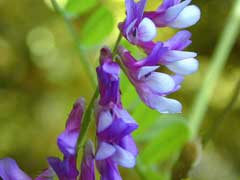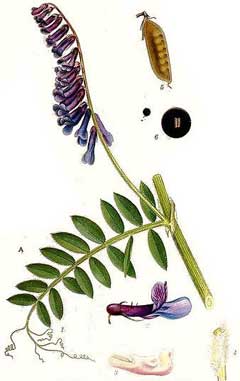 |
|
flickr.com/people/51035743246@N01 |
 |
|
Translate this page:
Summary
Physical Characteristics

 Vicia villosa is a PERENNIAL CLIMBER growing to 1.8 m (6ft). It is in flower from June to September. The species is hermaphrodite (has both male and female organs) and is pollinated by Bees. The plant is self-fertile.
Vicia villosa is a PERENNIAL CLIMBER growing to 1.8 m (6ft). It is in flower from June to September. The species is hermaphrodite (has both male and female organs) and is pollinated by Bees. The plant is self-fertile.
It can fix Nitrogen.
Suitable for: light (sandy), medium (loamy) and heavy (clay) soils and prefers well-drained soil. Suitable pH: mildly acid, neutral and basic (mildly alkaline) soils. It can grow in semi-shade (light woodland) or no shade. It prefers moist soil.
UK Hardiness Map
US Hardiness Map
Synonyms
Plant Habitats
Cultivated Beds;
Edible Uses
Edible Parts: Leaves Seed
Edible Uses:
Seed[2]. No more details are given. Used as a vegetable[177]. No more details are given.
References More on Edible Uses
Medicinal Uses
Plants For A Future can not take any responsibility for any adverse effects from the use of plants. Always seek advice from a professional before using a plant medicinally.
None known
References More on Medicinal Uses
The Bookshop: Edible Plant Books
Our Latest books on Perennial Plants For Food Forests and Permaculture Gardens in paperback or digital formats.

Edible Tropical Plants
Food Forest Plants for Hotter Conditions: 250+ Plants For Tropical Food Forests & Permaculture Gardens.
More

Edible Temperate Plants
Plants for Your Food Forest: 500 Plants for Temperate Food Forests & Permaculture Gardens.
More

More Books
PFAF have eight books available in paperback and digital formats. Browse the shop for more information.
Shop Now
Other Uses
Green manure
Used as a spring or autumn sown green manure. The seed can be sown in September to overwinter, or as late as October for a greenhouse green manure[87].
Special Uses
Nitrogen Fixer
References More on Other Uses
Cultivation details
Succeeds in any well-drained soil in a sunny position if the soil is reliably moist throughout the growing season, otherwise it is best grown in semi-shade[200]. Cultivated for its edible seed in N. and C. Europe[2]. This species is not very deep rooting[87]. This species has a symbiotic relationship with certain soil bacteria, these bacteria form nodules on the roots and fix atmospheric nitrogen. Some of this nitrogen is utilized by the growing plant but some can also be used by other plants growing nearby[200].
References Carbon Farming Information and Carbon Sequestration Information
Temperature Converter
Type a value in the Celsius field to convert the value to Fahrenheit:
Fahrenheit:
The PFAF Bookshop
Plants For A Future have a number of books available in paperback and digital form. Book titles include Edible Plants, Edible Perennials, Edible Trees,Edible Shrubs, Woodland Gardening, and Temperate Food Forest Plants. Our new book is Food Forest Plants For Hotter Conditions (Tropical and Sub-Tropical).
Shop Now
Plant Propagation
Pre-soak the seed for 24 hours in warm water and then sow in situ in spring or autumn.
Other Names
If available other names are mentioned here
Native Range
TEMPERATE ASIA: Afghanistan, Cyprus, Iran, Iraq, Israel, Lebanon, Syria, Turkey, Azerbaijan, Georgia, Russian Federation (Checheno-Ingushetia, Dagestan, Krasnodar, Stavropol), Kazakhstan, Kyrgyzstan, Tajikistan, Turkmenistan, Uzbekistan EUROPE: Czechoslovakia, Austria, Switzerland, Germany, Hungary, Poland, Belarus, Estonia, Lithuania, Latvia, Moldova, Russian Federation (Cuvašskaja Respublika, Kalmykija, Respublika, Mordovija, Respublika, Tatarstan, Belgorod, Bryansk, Kaliningrad, Kursk, Lipeckaja oblast, Orel, Rostov, Saratov, Smolensk, Tambov, Tula, Ulyanovsk, Volgogradskaja oblast, Voronezh, Yaroslavl), Ukraine (incl. Krym), Former Yugoslavia, Albania, Bulgaria, Greece (incl. Crete), Italy (incl. Sardinia, Sicily), Romania, Spain (incl. Baleares), France (incl. Corsica), Portugal AFRICA: Spain (Canarias), Algeria, Egypt, Libya, Morocco, Tunisia
Weed Potential
Right plant wrong place. We are currently updating this section.
Please note that a plant may be invasive in one area but may not in your area so it's worth checking.
Conservation Status
IUCN Red List of Threatened Plants Status :

| Related Plants
|
| Latin Name | Common Name | Habit | Height | Hardiness | Growth | Soil | Shade | Moisture | Edible | Medicinal | Other |
| Artemisia ludoviciana | White Sage, Louisiana Sage, Prairie Sage, Western Mugwort | Perennial | 1.0 |
3-9
| M | LM | SN | DM | 2 | 2 | 2 |
| Artemisia ludoviciana gnaphalodes | White Sage | Perennial | 1.0 |
4-8
| | LM | SN | DM | 0 | 2 | 1 |
| Avena ludoviciana | Oats | Annual | 0.0 |
-
| | LMH | N | DM | 2 | 0 | 2 |
| Lactuca ludoviciana | Western Wild Lettuce, Biannual lettuce | Biennial | 1.2 |
0-0
| | LM | SN | M | 2 | 2 | |
| Orobanche ludoviciana | Broomrape, Louisiana broomrape | Perennial | 1.5 |
0-0
| | LMH | FSN | M | 1 | 1 | 0 |
| Vicia americana | American Vetch, Mat vetch | Perennial | 1.0 |
4-7
| | LMH | SN | M | 2 | 1 | 4 |
| Vicia amoena | | Perennial | 1.0 |
-
| | LMH | SN | M | 1 | 0 | |
| Vicia amurensis | | Perennial | 1.5 |
-
| | LMH | SN | M | 1 | 0 | |
| Vicia articulata | One-Flower Vetch | Annual | 0.6 |
-
| | LMH | SN | M | 1 | 0 | 3 |
| Vicia benghalensis | Purple Vetch | Annual/Perennial | 0.6 |
-
| F | LMH | SN | M | 0 | 0 | 3 |
| Vicia caroliniana | Carolina vetch, Carolina wood vetch | Perennial | 0.6 |
3-9
| M | LMH | FSN | M | 0 | 2 | 4 |
| Vicia cracca | Tufted Vetch, Bird vetch, Cow vetch | Perennial Climber | 1.8 |
4-8
| | LMH | SN | M | 1 | 1 | 3 |
| Vicia ervilia | Bitter Vetch | Annual | 0.6 |
-
| | LMH | SN | M | 1 | 0 | |
| Vicia faba equina | Horsebean | Annual | 1.0 |
4-8
| F | LMH | SN | M | 3 | 0 | 3 |
| Vicia faba major | Broad Bean, Fava Bean | Annual | 1.0 |
4-10
| F | LMH | SN | M | 4 | 1 | 3 |
| Vicia faba minuta | Tick Bean | Annual | 1.0 |
4-8
| F | LMH | SN | M | 3 | 0 | 3 |
| Vicia gigantea | Giant Vetch | Perennial | 1.0 |
4-8
| | LMH | SN | M | 2 | 1 | 3 |
| Vicia grandiflora kitaibeliana | large yellow vetch | Annual | 0.0 |
-
| | LMH | SN | M | 2 | 0 | |
| Vicia heptajuga | | Perennial | 0.0 |
-
| | LMH | SN | M | 1 | 0 | |
| Vicia hirsuta | Hairy Tare, Tiny vetch | Annual | 0.5 |
4-9
| | LMH | SN | M | 2 | 0 | 3 |
| Vicia hirticalycina | | Perennial | 0.0 |
-
| | LMH | SN | M | 1 | 0 | |
| Vicia japonica | | Perennial | 1.5 |
-
| | LMH | SN | M | 1 | 0 | |
| Vicia monantha | Hard Vetch, Barn vetch | Annual | 0.0 |
0-0
| | LMH | SN | M | 2 | 0 | 3 |
| Vicia narbonensis | French Vetch, Purple broad vetch | Annual | 1.0 |
0-0
| | LMH | SN | M | 2 | 0 | |
| Vicia nipponica | | Perennial | 0.8 |
-
| | LMH | SN | M | 1 | 0 | |
| Vicia noeana | | Annual | 0.6 |
-
| | LMH | SN | M | 1 | 0 | |
| Vicia pisiformis | Pea Vetch, Pale-flower vetch | Perennial | 1.8 |
0-0
| | LMH | SN | M | 1 | 0 | |
| Vicia pseudo-orobus | | Perennial | 1.5 |
-
| | LMH | SN | DM | 1 | 0 | |
| Vicia sativa | Winter Tares, Garden vetch, Subterranean vetch | Annual Climber | 1.2 |
4-8
| F | LMH | SN | M | 3 | 0 | 3 |
| Vicia sativa leucosperma | Winter Tares | Annual Climber | 1.2 |
4-8
| F | LMH | SN | M | 3 | 0 | 3 |
|
|
Growth: S = slow M = medium F = fast. Soil: L = light (sandy) M = medium H = heavy (clay). pH: A = acid N = neutral B = basic (alkaline). Shade: F = full shade S = semi-shade N = no shade. Moisture: D = dry M = Moist We = wet Wa = water.
Now available:
Food Forest Plants for Mediterranean Conditions
350+ Perennial Plants For Mediterranean and Drier Food Forests and Permaculture Gardens.
[Paperback and eBook]
This is the third in Plants For A Future's series of plant guides for food forests tailored to
specific climate zones. Following volumes on temperate and tropical ecosystems, this book focuses
on species suited to Mediterranean conditions—regions with hot, dry summers and cool, wet winters,
often facing the added challenge of climate change.
Read More
Expert comment
Author
Roth.
Botanical References
50
Links / References
For a list of references used on this page please go here
Readers comment
© 2010, Plants For A Future. Plants For A Future is a charitable company limited by guarantee, registered in England and Wales. Charity No. 1057719, Company No. 3204567.